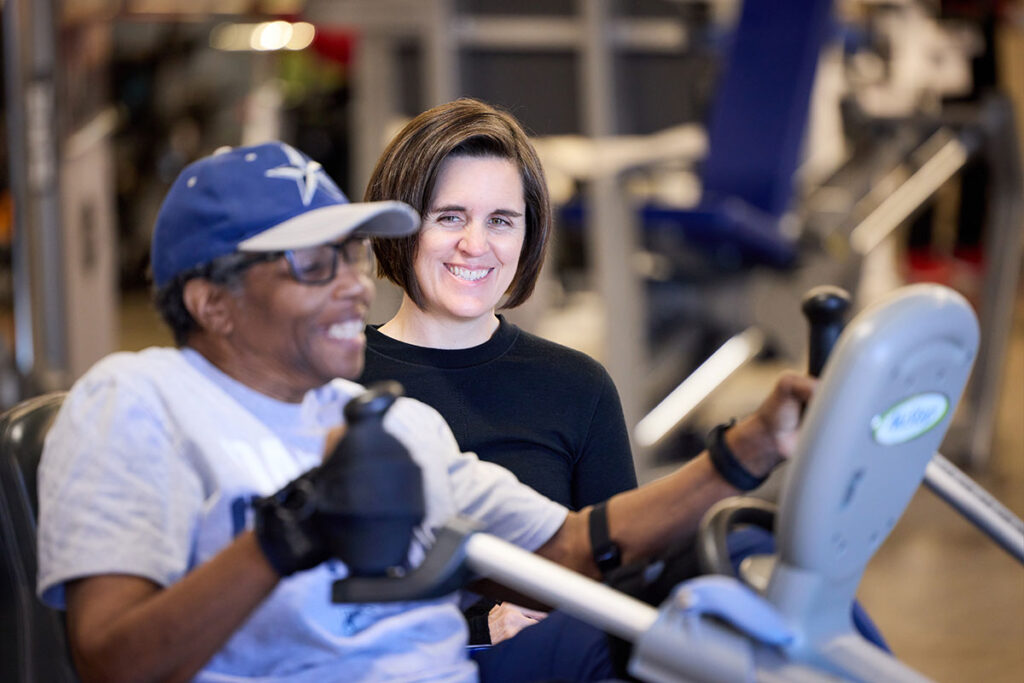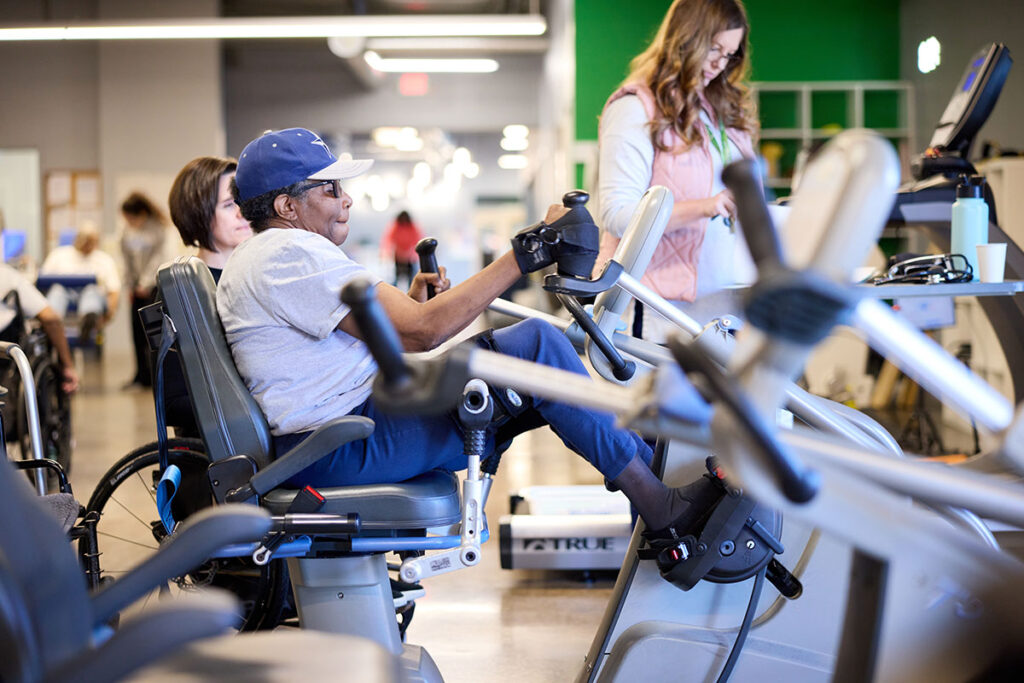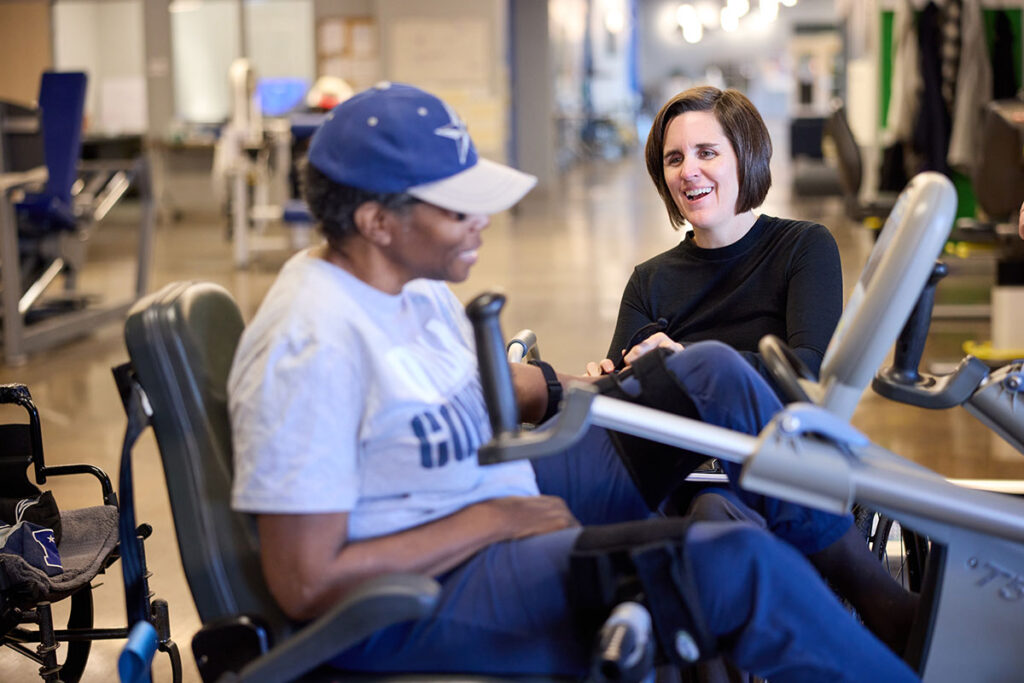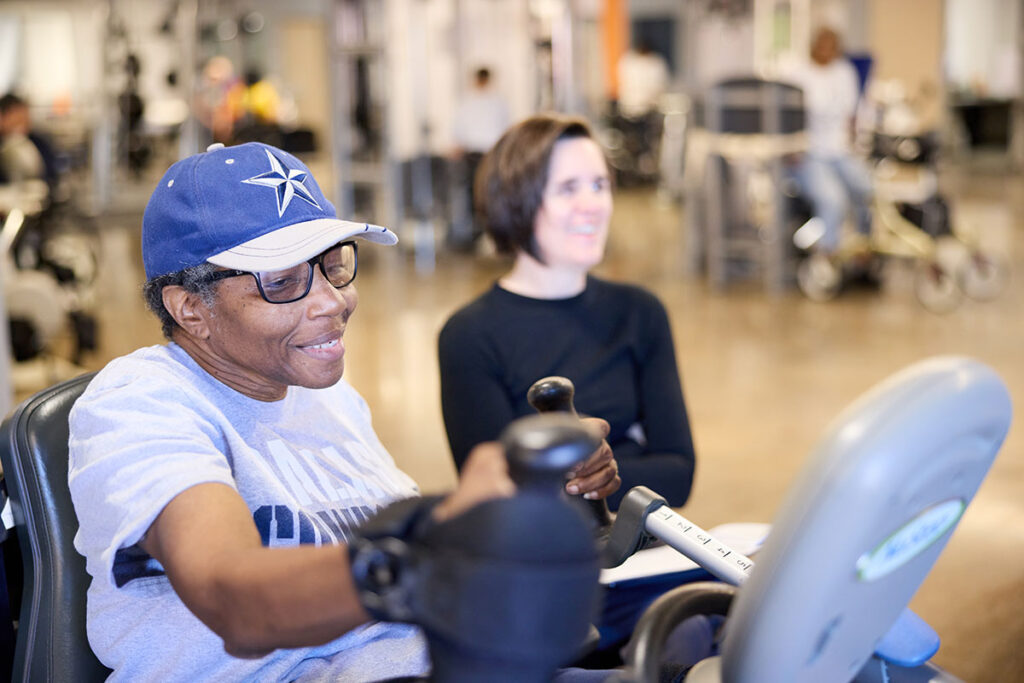
On a Friday morning, Delphia Brown, a retired social worker and Washington University alumna, worked out at a gym, pushing the pedals and pumping the handlebars of a recumbent cross trainer. The exercise equipment measured Brown's heart rate and pushed back - not only with increasing resistance but with a warning for her to slow down when her heart rate approached the machine's pre-set target for her age.
"Don't listen to it!" said personal trainer Annie Morrow, while Kerri Morgan, an associate professor of occupational therapy and of neurology at Washington University School of Medicine in St. Louis, chuckled and jotted down some notes. Picking up a sheet of paper with a scale indicating exertion level, from six to 20, Morrow asked Brown what number she was at on the scale and whether she felt she could continue.
"As long as the music is right, I can keep going," said Brown, her arms moving in sync with Stevie Wonder's "Signed, Sealed, Delivered (I'm Yours)," which played over the speakers in the Stephen A. Orthwein Center, a wheelchair-accessible gym in St. Louis operated by Paraquad, an organization that helps people with disabilities achieve independence. More than just exercise, the workout was part of a clinical trial led by Morgan. Brown, who uses a wheelchair, is a participant in the trial, which aims to define how exercise affects cardiovascular health in people who use wheelchairs.

Over 3 million people in the United States use wheelchairs for mobility. Because they use fewer muscles to move, they are at greater risk for conditions related to heart health, such as obesity and diabetes. These conditions can be prevented or improved with regular moderate-intensity physical activities. But what specifically constitutes moderate exercise has mostly been defined in studies of nondisabled people. Many commonly listed examples of moderate exercise - such as brisk walking, pushing a lawn mower, hiking or rollerblading - assume an ability to walk.
"We understand that the more you move, the better it is for your body, especially if you have a disability," Morgan said. "But there isn't much information out there on what level of exercise truly changes the health of wheelchair users. It's hard to compare people with disabilities to people without, because people with disabilities are using less muscle mass and smaller muscle groups. When you're using all four limbs or all of your muscle masses to do physical activities, you're going to have a lot better shot at changing your cardiometabolic health. We don't know what level of physical activity is necessary for this group to actually change measures of their cardiometabolic health, such as lowering blood pressure, controlling diabetes or lowering cholesterol, for example. We are hopeful our research will help fill this gap in knowledge."
Morgan's study is comparing the benefits of exercise with and without active coaching, and how such exercise affects cardiovascular health in participants who use wheelchairs for a variety of reasons. The study partners with exercise trainers such as Morrow, director of the Orthwein Center, and is funded with a five-year grant Morgan received from the National Institutes of Health (NIH). She plans to study the effects of the exercise regimens in 110 participants, each of whom will be followed for up to 14 weeks.

Brown has used a wheelchair for about a year. She has been diagnosed with multiple sclerosis and diabetes, and she recently underwent surgery and received radiation and chemotherapy to treat breast cancer. Getting back on her feet again is her goal, and she is trying to improve her health through exercise on adaptive equipment at the Orthwein Center.
After receiving information on the health benefits of exercise, and instruction on how to use the exercise equipment, participants are randomized into two groups. Both groups go to the gym three times a week. Members of one group perform self-directed exercise. Participants in the other group work with trainers, who guide them through an intensive exercise regimen designed to work up to achieving moderate-intensity physical activity for a total of 150 minutes each week. Morgan said some participants may reach that goal by the end of the study and others may not.
As part of the study, Morgan and her colleagues plan to measure participants' oxygen-uptake levels, along with their heart rates and other measures aimed at quantitatively defining levels of exercise intensity. Participants also are asked to give a number, on a scale of six to 20, representing their perceived exertion during exercise.
A typical session may consist of a warmup followed by cardio exercise, strength training, and then cool-down exercises. Brown's cardio exercise was via a recumbent cross trainer designed for moderate-intensity exercise. She moved to an adaptive cable machine to build arm strength, and then stretched to cool down.

While Brown wants to be able to walk again, other participants may have different goals.
"People come in because they want to work on improving something," Morgan explained. "Some people want more functional movement; some want to work on their overall health; and some want to lose weight and build strength so that transfers into and out of their wheelchairs are easier. Many want to be more independent, so we are trying to help them see what exercise does for their health and what levels it can take them to."
The study participants have a wide range of movement abilities and use wheelchairs for various reasons - due to multiple sclerosis, stroke, spinal cord injury, traumatic brain injury or Parkinson's disease, among other reasons. Because of this, regimens are tailored to each participant based on their levels of physical function, goals, and views on exercise. Broad inclusion criteria are not seen in many large clinical trials, making the study unique in its diverse selection of participants.
"We're learning that you must be intentional if you want to include people with disabilities in your clinical trials," Morgan said. "We have people with all kinds of diagnoses come in with different fitness levels, and we need to match them with the best possible tests and equipment. If somebody has arm and leg movement and we only test them on their arms, we are not truly getting a good understanding of their functional level."
Including people of diverse abilities in exercise and cardiovascular research is an important subject for Morgan. A wheelchair user herself, Morgan is also a distinguished athlete. She was the first woman to make the U.S. wheelchair rugby team, and she represented the U.S. in the Paralympic Games in Beijing, London and Rio, where she won a total of four medals in track and field. She also has 10 world championship medals in various distance races.
She and Morrow understand well the effects of exercise and motivation.
"The participants that we have so far in this study are very motivated - they want to push themselves," Morrow said. "A month into working with our participants, we started to see progress. It's exciting for them to feel that positive changes are, in fact, occurring as well."

Brown, who was a track and field athlete in high school and has been physically active throughout her life, said she feels she is getting stronger. Brown earned her master's degree in social work from Washington University and had a long career in the field, working as a social worker for the Salvation Army, as a substance abuse counselor and supervisor for several drug treatment centers, and with patients managing HIV at an organization that serves patients with HIV/AIDS in the St. Louis region. She served St. Louis Public Schools as a social worker before retiring in 2021. Now, her focus is on her faith, her family and her health.
"I have six grandchildren I see every weekend," Brown said. "I probably need to do a bit more than walking to take care of them. I want to improve my physical condition with exercise. It's not an overnight process, but I am getting there."
Morgan's goal is to help Brown and people like her gain the knowledge and resources necessary to have equitable access to the benefits of exercise.
"For people with mobility disabilities, there are a lot of barriers to navigate just to be able to exercise," Morgan said. "There is a tremendous need for improvement since people who use wheelchairs experience cardiovascular disease at much higher rates than the general population. My passion is to help people in this community by providing support for exercise and evidence about exercise regimens that may make a meaningful difference in cardiometabolic health, so that people have the knowledge they need to live healthier lives."
About Washington University School of Medicine
WashU Medicine is a global leader in academic medicine, including biomedical research, patient care and educational programs with 2,900 faculty. Its National Institutes of Health (NIH) research funding portfolio is the second largest among U.S. medical schools and has grown 56% in the last seven years. Together with institutional investment, WashU Medicine commits well over $1 billion annually to basic and clinical research innovation and training. Its faculty practice is consistently within the top five in the country, with more than 1,900 faculty physicians practicing at 130 locations and who are also the medical staffs of Barnes-Jewish and St. Louis Children's hospitals of BJC HealthCare. WashU Medicine has a storied history in MD/PhD training, recently dedicated $100 million to scholarships and curriculum renewal for its medical students, and is home to top-notch training programs in every medical subspecialty as well as physical therapy, occupational therapy, and audiology and communications sciences.
Originally published on the School of Medicine website






